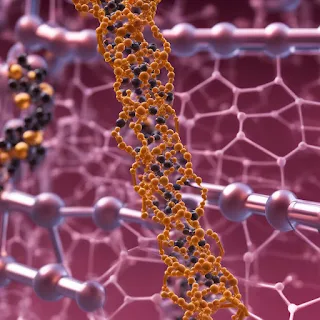Enhancing Single-Molecule Transistors with Graphene Edge Interference
Graphene Edge Interference Boosts Single-Molecule Transistors
In a groundbreaking development for molecular electronics, researchers have harnessed the power of graphene edge interference to create highly efficient single-molecule transistors. This new technology, reported in Nature Nanotechnology, offers a promising solution to the challenges of fast switching speed, stability, and efficiency that have plagued previous attempts at molecular electronics.
Molecular electronics, the ultimate downscaling limit of transistors, has long been a holy grail for researchers. The ability to control and understand molecules at the nanoscale interface has led to the demonstration of several single-molecule transistors. However, achieving fast switching speed, good stability, and efficiency has remained elusive.
Now, a team of researchers has reported a single-molecule three-terminal transistor that overcomes some of these limitations. The devices use graphene electrodes and a voltage gate, showing exceptional properties due to the harnessing of quantum interference effects.
The researchers first created graphene electrodes with irregular wedge-shaped protrusions, where two zigzag edges merge into a locally armchair edge. This is near the presumed molecular binding site in the devices. They then attached a porphyrin molecule to the graphene wedges.
The quantum nature of electrons traveling across molecular-scale circuits gives rise to fascinating effects arising from the phase-coherent character of electron transport. Destructive quantum interference (DQI) is the suppression of electron transmission at certain energies arising from the phase shifts of different orbital resonances involved in transport or of different spatial pathways. In the devices reported, DQI appears in the graphene electrodes, leading to a suppression of electron transmission at certain energies.
The researchers harnessed this DQI antiresonance to define the OFF state of the transistor, while energies close to molecular resonances, where transmission is high, define the ON state. By changing the gate voltage of the device, they could tune molecular levels between these two states, achieving an ON/OFF ratio of 104. This value is two orders of magnitude higher than previous single-molecule transistors using Au electrodes.
The sharp DQI antiresonance allows for simultaneous high ON/OFF ratios and efficient switching, with the devices exhibiting switching at the thermionic limit. The chip-like architecture allows for rapid modulation of the gate voltage and robust switching in the kHz regime, much faster than the frequencies achieved by electrochemical gating in previous single-molecule transistors.
The devices are also very stable, with the ability to switch for 105 cycles at different temperatures over several weeks. DQI in the graphene electrodes is robust, and the chemical bonds to the graphene edges are more stable than usual π–π stacking in molecule-graphene interfaces.
While the devices currently only work at temperatures up to 100 K, the potential for this technology is enormous. Atomic-scale characterization of the graphene interface and progress in the creation of tailored graphene edges are immediate research directions that can be undertaken to address the outstanding issues of the devices presented by Chen et al.
This work is an exciting step in single-molecule transistor development, demonstrating the potential of graphene edge interference to revolutionize molecular electronics.
Source: <https://www.nature.com/articles/s41565-024-01634-0>
In a groundbreaking development for molecular electronics, researchers have harnessed the power of graphene edge interference to create highly efficient single-molecule transistors. This new technology, reported in Nature Nanotechnology, offers a promising solution to the challenges of fast switching speed, stability, and efficiency that have plagued previous attempts at molecular electronics.
Molecular electronics, the ultimate downscaling limit of transistors, has long been a holy grail for researchers. The ability to control and understand molecules at the nanoscale interface has led to the demonstration of several single-molecule transistors. However, achieving fast switching speed, good stability, and efficiency has remained elusive.
Now, a team of researchers has reported a single-molecule three-terminal transistor that overcomes some of these limitations. The devices use graphene electrodes and a voltage gate, showing exceptional properties due to the harnessing of quantum interference effects.
The researchers first created graphene electrodes with irregular wedge-shaped protrusions, where two zigzag edges merge into a locally armchair edge. This is near the presumed molecular binding site in the devices. They then attached a porphyrin molecule to the graphene wedges.
The quantum nature of electrons traveling across molecular-scale circuits gives rise to fascinating effects arising from the phase-coherent character of electron transport. Destructive quantum interference (DQI) is the suppression of electron transmission at certain energies arising from the phase shifts of different orbital resonances involved in transport or of different spatial pathways. In the devices reported, DQI appears in the graphene electrodes, leading to a suppression of electron transmission at certain energies.
The researchers harnessed this DQI antiresonance to define the OFF state of the transistor, while energies close to molecular resonances, where transmission is high, define the ON state. By changing the gate voltage of the device, they could tune molecular levels between these two states, achieving an ON/OFF ratio of 104. This value is two orders of magnitude higher than previous single-molecule transistors using Au electrodes.
The sharp DQI antiresonance allows for simultaneous high ON/OFF ratios and efficient switching, with the devices exhibiting switching at the thermionic limit. The chip-like architecture allows for rapid modulation of the gate voltage and robust switching in the kHz regime, much faster than the frequencies achieved by electrochemical gating in previous single-molecule transistors.
The devices are also very stable, with the ability to switch for 105 cycles at different temperatures over several weeks. DQI in the graphene electrodes is robust, and the chemical bonds to the graphene edges are more stable than usual π–π stacking in molecule-graphene interfaces.
While the devices currently only work at temperatures up to 100 K, the potential for this technology is enormous. Atomic-scale characterization of the graphene interface and progress in the creation of tailored graphene edges are immediate research directions that can be undertaken to address the outstanding issues of the devices presented by Chen et al.
This work is an exciting step in single-molecule transistor development, demonstrating the potential of graphene edge interference to revolutionize molecular electronics.
Source: <https://www.nature.com/articles/s41565-024-01634-0>


Comments
Post a Comment